Content
Growing umbrella Iberis from seeds will not take much time and effort. The plant is unpretentious, therefore, the care for it is minimal. It can be planted directly with seeds or seedlings in open ground.
Detailed description of the species
Umbrella is one of the most popular types of Iberis grown as a garden crop. This herb belongs to the Cabbage (Cruciferous) family. The zones of its natural habitat include the south of Russia, the Caucasus, and Europe.
Iberis gets its name from Iberia. This is how the Iberian Peninsula was called in ancient times. The people also call the plant Iberian, stennik, peppercorn, variegated. Its main characteristics:
- height 0.15-0.4 m;
- stems are smooth and glabrous, but with a light down;
- pronounced branching;
- tap root;
- diameter of umbrella inflorescences up to 5-6 cm;
- color, depending on the variety, white, pink, lilac, violet, purple, lilac;
- flowers are small, consist of 4 petals, open at the same time, densely located;
- the aroma is pleasant and delicate;
- leaf plates are small and rounded, the amount is small;
- flowering lasts from 2 months.
Types and varieties
There are many varieties of Umbrella Iberis. They differ mainly in color and height of the bushes. All representatives of the species are good honey plants.
Umbrella Iberis Blackberry meringue
The variety of the umbrella Iberis Blackberry meringue is represented by a mixture of colors - milky white, lilac, purple-violet flowers with a strong aroma. The average height of the bushes is 0.25-0.3 m. Flowering begins in June and lasts 2 months.

Inflorescences of Blackberry meringues reach 5 cm in diameter
Umbrella Iberis Pomegranate Ice
In the photo of the umbrella Iberis Pomegranate Ice in the flower bed, you can clearly see why this variety is so named. The reason is the contrasting color - a mixture of snow-white and dark pomegranate inflorescences. They reach 5 cm in diameter. Plant height is 0.25-0.4 m.
Iberis umbrella Pomegranate ice seedlings are rarely planted. Gardeners prefer to grow it from seeds that can be sown even before winter.
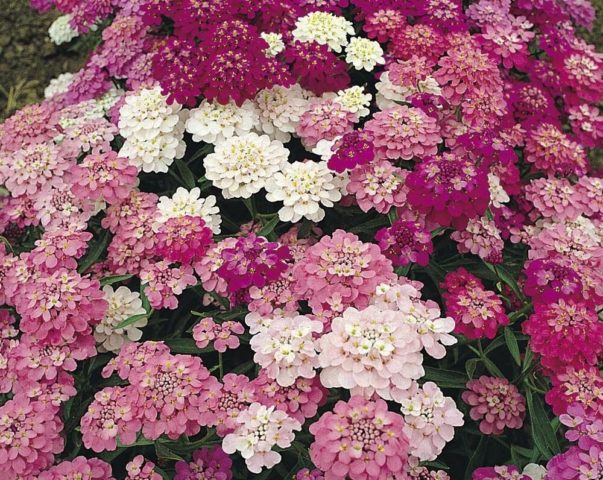
Pomegranate ice blooms in June-July, has a strong but pleasant aroma
Umbrella Iberis Lilician
The variety Lilitsiana has a pale lilac color of inflorescences with a pronounced honey aroma. Plants are sprawling, but small.
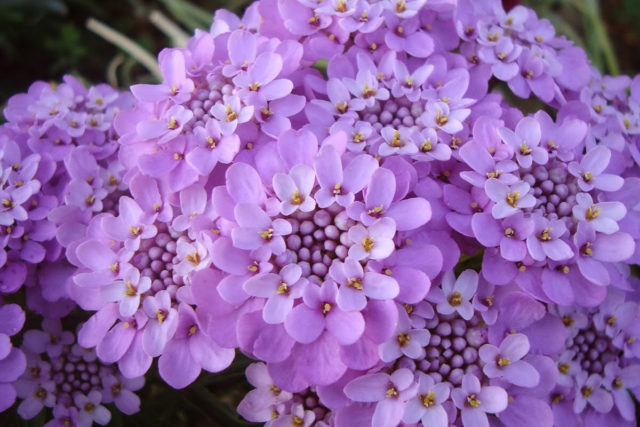
Liliciana grows to 0.2-0.3 m
Umbrella Iberis Violet Cardinal
The Violet Cardinal variety got its name for the delicate purple color of the flowers. Their diameter is only 1.5-2 cm. They are collected in dense corymbose inflorescences.
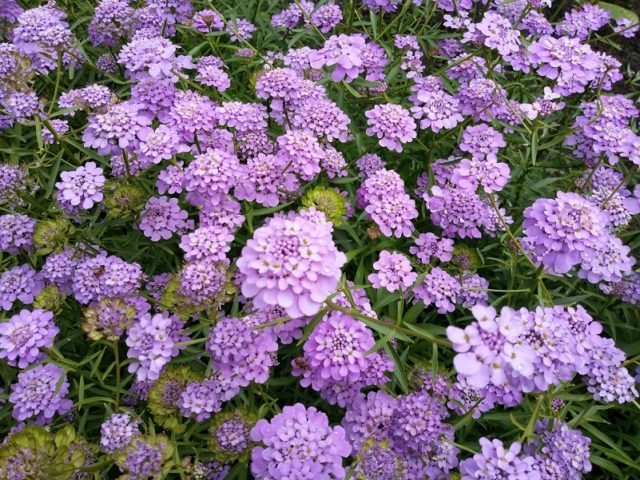
The delicate scent of Violet Cardinal attracts bees and butterflies
Berry jelly
The Berry Jelly variety is characterized by a contrasting color - a mixture of snow-white and pink flowers. Plant height 0.25-0.4 m. Inflorescences reach 5 cm in diameter.
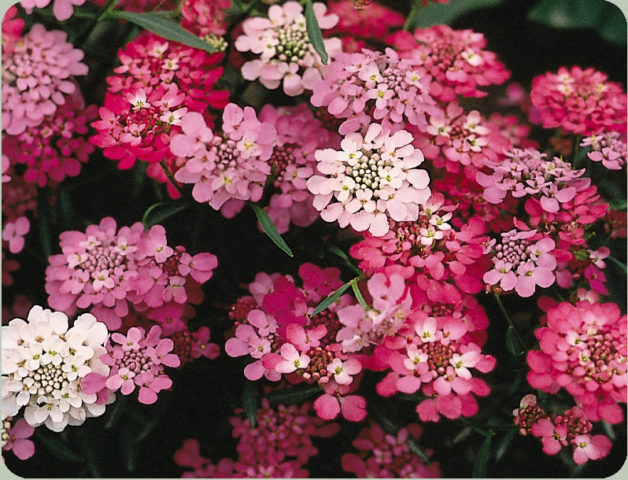
Blooming Berry Jelly begins in July and lasts until September
Pink dream
The Pink Dream variety has a pink or pink-purple color.The diameter of the flowers is not more than 2.5 mm. This annual grows up to 0.3-0.35 m. The plant can withstand short frosts down to -4 ° C. Its flowering is plentiful, the smell is pleasant.
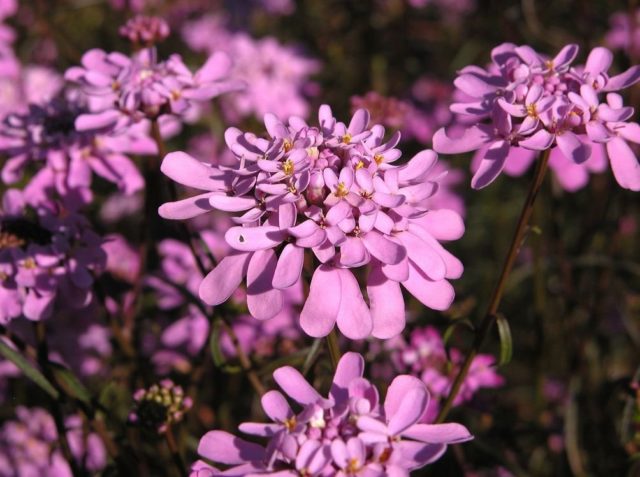
Blooming Pink Dream falls on June-September
Iceberg
The name of the Iceberg variety comes from the snow-white color of the inflorescences. They reach 10 cm in diameter. Plant height is 0.35-0.4 m. Flowering lasts more than 2 months, and begins at the end of May.
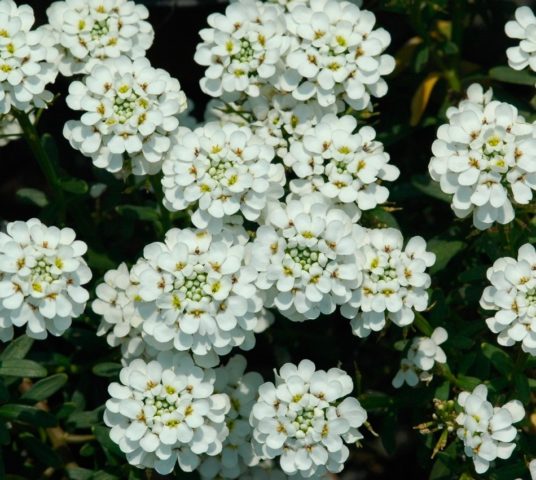
In shape and size, Iceberg inflorescences resemble hyacinths
Fairy Mixtche
Fairy Mixture is represented by a mixture of flowers of different colors. Plants are compact, suitable for a small area.
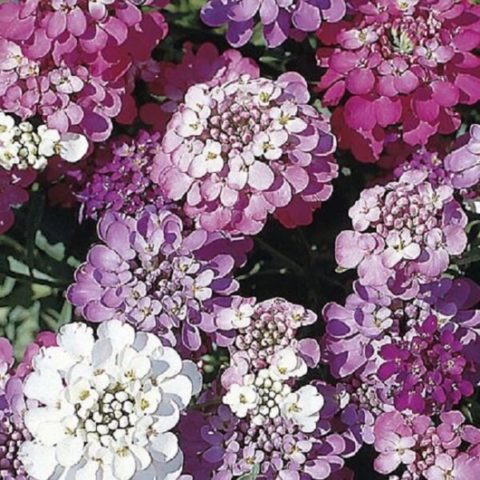
The variety grows no more than 0.2-0.25 m in height
Red Rash
Iberis Red Rash (Red Rash) has a carmine red color. Plant height of this variety is 0.3 m.
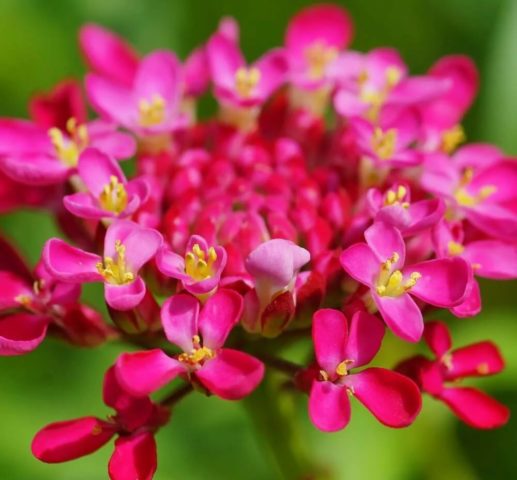
Red Rush is not as common as others
Amethyst
Amethyst is one of the varieties of umbelliferous Iberis with a lilac color. It has small and fragrant buds, flowering begins in June and lasts 2 months. The plants are spreading, but their height is small - 0.3-0.35 m.
Practicing cultivation from seeds of Iberis Umbelliferae Amethyst in the open field. Sowing is carried out in the spring or before winter.
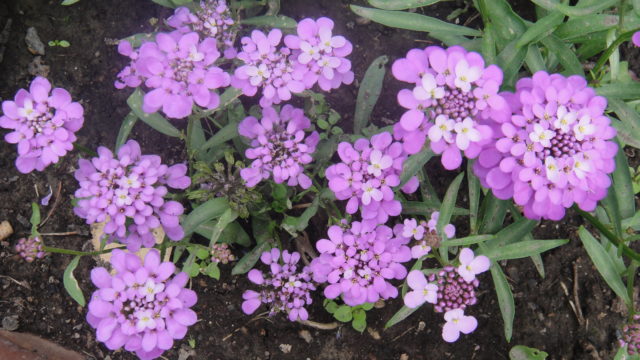
The diameter of the inflorescences of the Amethyst variety is 5-6 cm
Application in landscape design
Iberis umbrella is widely used in landscape design. Its popularity is due to the variety of colors, splendor and duration of flowering.
This species is often used as a curb plant. It is planted along the paths in a line or in small islands.
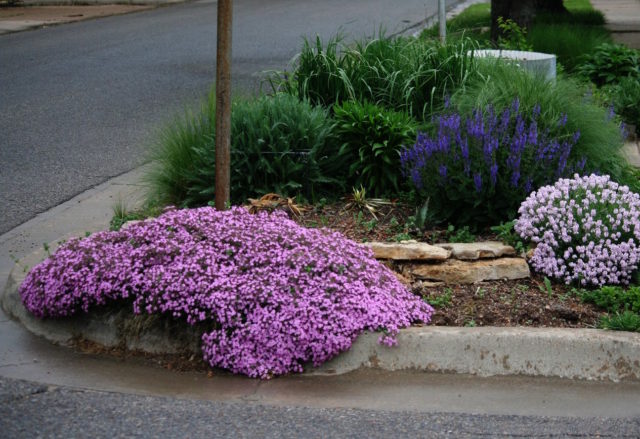
The islets of the umbrella Iberis liven up the grayness of the asphalt well
The plant is planted in flower beds, ridges, mixborders. These can be flowers of the same shade or contrasting color. Bushes are undersized, therefore they are placed in the foreground.

Umbrella Iberis of any color looks good against the background of bushes and trees
The plant is often used in rockeries and rock gardens. The flower looks good on natural slopes and artificial elevations.

Umbrella Iberis looks good even among stones, gravel
In the photo in the garden, you can see the umbrella Iberis in combination with various plants. Conifers and flowering shrubs will be a good background. In the neighborhood you can plant:
- alissum;
- marigolds (undersized varieties);
- gazania;
- herbal cloves;
- creeping tenacious;
- large-flowered bell;
- sedum;
- creeping phlox;
- cineraria.
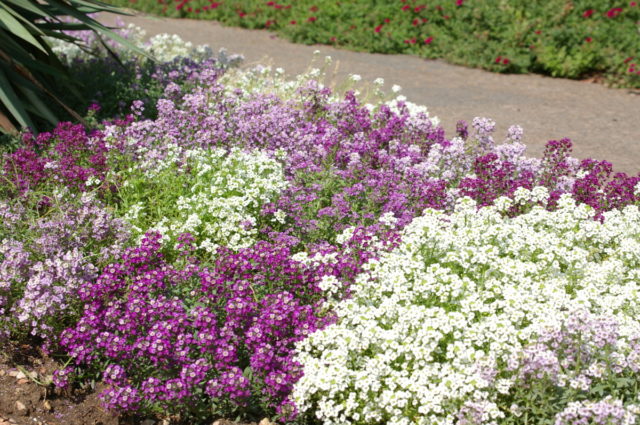
The combination of flowers of different colors looks spectacular

Iberis umbellate is often planted along more expensively on its own or against the background of tall plants, shrubs, trees
Breeding features
Umbrella Iberis can be propagated by seed or cuttings. The first option is more difficult. The material is immediately sown in open ground or seedlings are first grown. The seeds can be purchased at the store or prepared by yourself. To do this, you need to collect the pods and dry them so that they open. The resulting seeds are stored in a dry and dark place. They are planted the next year, the material remains viable for up to 3 years.
It is not difficult to propagate a plant by cuttings. The algorithm is as follows:
- After flowering, cut the cuttings, each no more than 5 cm long.
- Process the material with phytohormones.
- Root the cuttings at a minimum interval of 15 cm. This can be done outdoors or in a greenhouse.
Growing seedlings
Umbrella Iberis can be planted with seedlings. In this case, flowering begins earlier.
Sowing seeds for seedlings is carried out in March. Due to the sensitivity to transplanting, separate containers must be taken immediately to eliminate the need for a pick. Algorithm for growing seedlings:
- Prepare the soil mixture. For the prevention of diseases, it should be treated in one of the ways - a solution of potassium permanganate, calcining, freezing, heating with steam.
- Fill the prepared containers with soil, moisten it.
- Sow seeds, deepening by 0.1-0.2 mm.You can simply spread them over the surface and sprinkle with river sand.
- Cover the plantings with foil or glass, place them in a warm place. The optimum temperature is 15-18 ° C.
Seedlings are easy to care for. It is important to provide diffused light, regular ventilation. After the emergence of shoots, the shelter must be removed. Hardening begins 2 weeks before planting in open ground.
Planting and care in the open field
Umbrella Iberis is grown outdoors. The timing of planting, the right place and properly organized care are important.
Recommended timing
When growing Umbelliferae from seeds, it should be planted no earlier than mid-April. The exact timing depends on the climatic conditions. It is optimal when the daytime temperature is set at 16-18 ° C. You can prolong flowering by planting seeds at different times. An interval of 2-3 weeks is recommended.
The plant can be planted with seeds before winter. They do it in September. At the same time, the germination rate is less, but flowering begins earlier.
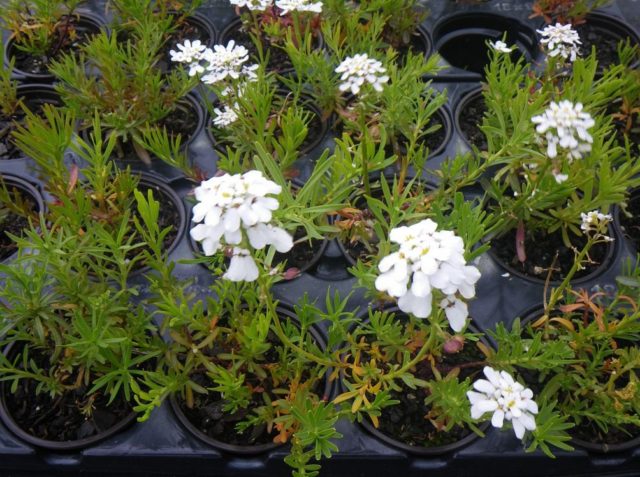
If you grow Iberis umbrella seedlings, then the first planting in the ground is carried out in May
Site selection and preparation
Umbrella Iberis does not like transplants, therefore it is important to immediately choose the right place for it. It must meet the following requirements:
- intense lighting;
- sandy or loamy soil;
- permeable soil;
- the reaction of the earth is neutral or slightly acidic;
- heavy soil and moisture stagnation are excluded.
Landing algorithm
Planting an umbrella Iberis is easy according to the following algorithm:
- Prepare the selected area - dig up, remove all weeds, loosen.
- Make grooves or holes.
- Sow seeds, deepening by 0.5-0.7 cm.Leave 15-20 cm between adjacent plants.
- Moisten the soil.
Seedlings appear in about 1.5-2 weeks. The plantings will need to be thinned out immediately.
If Iberis is planted in open ground with seedlings, then this should be done when its height is about 7 cm. Plants must be removed from containers carefully together with an earthen clod.
Watering and feeding schedule
Iberis umbrella is unpretentious. It should be specially watered only on hot days and prolonged drought. The rest of the time, the plant has enough moisture from the lower layers of the earth. For greater decorativeness, you can water it regularly as the soil dries.
The flower feels great without dressing if the soil is initially fertile. Fertilizers can be added for lush and longer flowering. Complex mineral compositions are effective. The plant is fed twice - when the first leaves appear and at the beginning of flowering.
Loosening
For the umbrella Iberis, the permeability of the soil is important, therefore it must be systematically loosened. This should be done after watering or heavy rainfall, while removing weeds.
Pruning
To maintain the decorative effect of the umbrella Iberis, it is recommended to regularly remove dead inflorescences. When the plant has faded, it should be cut by at least a third. If self-seeding is not planned, the pods must be removed in a timely manner.
Wintering
Umbrella Iberis is cultivated as an annual, therefore it is not necessary to prepare it for winter. Pruning of inflorescences and the plant itself is carried out for aesthetics.
Before winter, the Iberis must be dug up and burned. This measure serves as the prevention of diseases and pests. The freed area must be dug up, removing weeds, roots and debris.
Diseases and pests
Umbrella Iberis belongs to the Cruciferous family, therefore it is susceptible to diseases and pests characteristic of its representatives. One of the problems is downy mildew (downy mildew), which is expressed by a whitish bloom on the leaves. It is necessary to fight it with fungicides such as Gamair, Fitosporin-M, Alirina-B.For prevention, autumn digging of the soil and burning of plant residues are important.
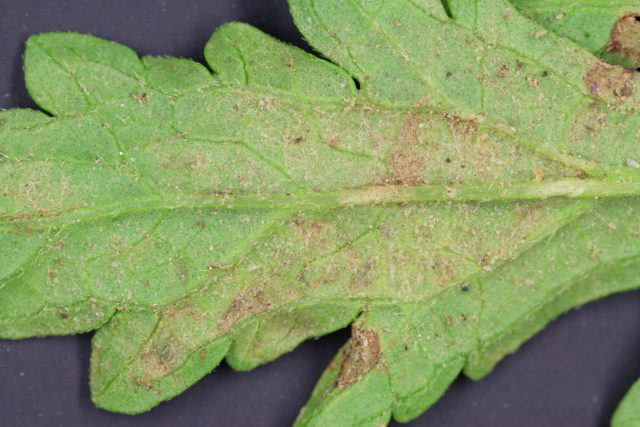
High humidity is a risk factor for the development of peronosporosis.
The fungal disease of Iberis is keela. It manifests itself as growths and swellings on the roots. The affected plants must be removed, and the rest must be treated with Fundazol or colloidal sulfur. For the prevention of disease, ash or fluff lime must be added to the ground during autumn digging.
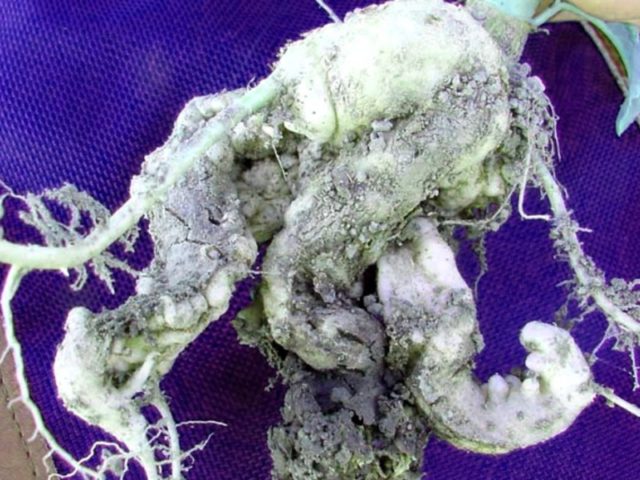
Roots affected by the keel poorly absorb moisture and the elements necessary for the plant
One of the enemies of the umbrella Iberis is the cabbage (cruciferous) flea. Its larvae and adults feed on leaves. You can get rid of the pest by dusting the plants with wood ash with tobacco dust or fluffy lime. Infusions and decoctions of dandelion, green wormwood, ash with laundry soap are also effective.

Cabbage flea can destroy young plantings in 1-2 days
Another enemy of the umbrella Iberis is the mealybug. These insects are also called felt or false pillows. You can fight the pest with chemicals: Kemifos, Fufanon, Tagor, Novaktion.
Mealybugs can be dealt with using folk methods. A solution of laundry soap, horsetail decoction is effective.

Mealybug feeds on plant sap, inhibits their development and immunity
Conclusion
Growing umbrella Iberis from seeds is also possible for inexperienced gardeners. The plant does not require special care, pleases with a long flowering even without additional fertilizing. All varieties of this type can be planted in open ground immediately with seeds.








